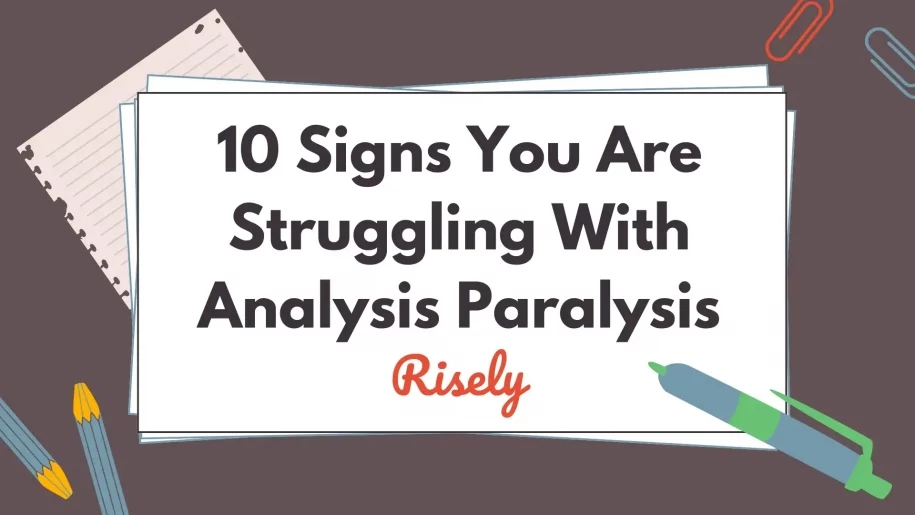10 Signs You’re Struggling with Analysis Paralysis at Work
The smart fox declares, “I have a hundred ways to escape when trouble approaches. You have only one.” As the dogs come, the cat quickly climbs a tree and scampers away while the fox counts and thinks through options until it’s too late. What you just witnessed is known as analysis paralysis, which was first mentioned centuries ago in Aesop’s fables, stories with moral lessons. In this article, we will look at ten signs to spot the presence of analysis paralysis in your life.What is Analysis Paralysis?
Analysis paralysis is a mental state where individuals are unable to make decisions or take action due to overthinking and fear of making the wrong choice. It often stems from the abundance of choices in modern life, leading to decision fatigue and a sense of feeling overwhelmed. This condition manifests through signs like indecision, procrastination, and excessive information gathering, hindering work, relationships, and personal well-being. Breaking free from analysis paralysis involves recognizing these signs and implementing strategies such as setting deadlines and embracing mistakes to move forward effectively. Let’s start with part one first, i.e., spotting analysis paralysis in action in our professional lives. Read more about decision making: 6 Hacks to Master Decision Making for Managers (With Examples)What are the Signs of Analysis Paralysis?
Analysis paralysis can show up in small ways during your work day. It might even look like unique personality traits or short moments of being unsure. To take back control of your decisions, you first need to understand how this condition affects you. Do you often doubt simple choices? Are you stuck thinking about the pros and cons over and over again? Let’s look at the main signs that suggest you could be dealing with analysis paralysis.#1 Indecision on even minor matters
#2 Procrastination due to fear of making the wrong choice
Why do we delay things? Sometimes, it happens because of the fear of making the wrong choice. This is especially true for those who have trouble making decisions. Each choice, big or small, comes with the worry about what could go wrong. It leaves feeling frozen even in situations that should take mere minutes to complete. This fear isn’t just about not trusting yourself. It’s more about being anxious about the finality and the inability to change choices later. Some people tend to wait, hoping the right answer will appear or that the decision will be made for them.But waiting only makes things worse. As deadlines approach and pressure increases, the fear of making a mistake grows, which can lead to even more inaction.
#3 Constantly seeking more information without reaching a conclusion
#4 Overanalyzing pros and cons to the point of stagnation
Making informed decisions means looking closely at the pros and cons of each choice. But for some of us, this process turns into analysis paralysis, where we overthink things and don’t make any progress. You may make long lists that show every tiny advantage and disadvantage, even the unimportant ones. This detailed analysis doesn’t help you see things clearly; it often makes doubts and worries grow. You start to fear missing an important detail or making a choice with incomplete information, which stops you from deciding anything at all. Because of this, you get stuck in a cycle of constant thinking. As a result, you can’t advance because you aim to reach a perfect understanding and complete certainty you may never find.#5 Avoiding decision-making responsibilities
#6 Experiencing anxiety over possible outcomes
#7 Repeatedly questioning past decisions
#8 Difficulty committing to a course of action
Making a decision is just the first step. You need to commit to an action to make plans real. However, some people struggle with this because they face analysis paralysis. Their indecisiveness goes beyond just picking an option. It also affects their ability to fully engage and complete a plan. Even after making a choice, you may hesitate. You might question the decision, consider other options, or look for constant support. This lack of commitment often comes from a fear of missing out on something better. You might doubt whether they considered all their choices. This way of acting leads to more problems in the professional sphere. The lack of trust in your plans pushes your team to doubt them, too. Projects can slow down, relationships can lose focus, and personal goals can stay out of reach.#9 Seeking excessive validation from others before deciding
#10 Feeling stuck in a loop of analysis without progress
Other Interesting Reads
How to Stop Analysis Paralysis from Impacting your Professional Life?
By using simple but effective techniques in your decision-making, you can take charge again. You will start making choices with confidence. Are you ready to choose action instead of doing nothing?#1 Get rid of perfectionism
Perfectionism often seems like a good trait. However, when it comes to making decisions, it leads to something called analysis paralysis. Striving for the perfect solution, which is usually not possible, creates high expectations and pressure to make the best choice. Perfectionists often fear failure and need to be in control. When they face a decision, they think about every possible outcome. They carefully look for any possible flaws. This causes them to feel they must gather way too much information, examine everything, and avoid any mistakes. Sadly, trying to be perfect can backfire. The more you look for the ideal solution, the harder it can be to find. You set high standards that they rarely achieve. It leads to feeling not good enough, putting things off, and ultimately feeling stuck in making a decision. Instead try working with a growth mindset coach and develop a worldview where mistakes are not the end, but just a turn.#2 Set clear and achievable goals
One of the best ways to beat analysis paralysis is to set SMART goals. Clear goals help you make decisions, sort through options, and decide what to do first. Knowing what you want to achieve makes the many choices feel less scary. It’s important to make sure your goals are clear and achievable. If you set goals that are too high, you might feel unmotivated and stuck overthinking. Start with small, manageable goals. It will help boost your confidence and give you a feeling of progress. You can break down bigger goals into smaller steps that are easier to handle. Having this clarity removes confusion and helps you make decisions more easily. Instead of feeling lost among too many choices, you can quickly look at options that fit your goals, making decision-making less complicated.#3 Limiting information intake to make better decisions
In the online era, we get a lot of information from many places. Staying informed is important, but too much information can make it hard to make decisions. In fact, limiting information can help us make better decisions. It’s important to know that more information does not always mean better choices. Too much information can lead to information overload, making it hard to tell what is important. Set some clear limits for yourself. Choose a specific time frame or decide how many resources you will look at before deciding. When you take control of the information you take in, you also make space for better thinking and analysis. Cut out the noise and focus on what really matters for your decision. This makes the process easier and less stressful.#4 Embrace the value of making mistakes for growth
A major fear that causes analysis paralysis is worrying about making the wrong decision. But, accepting that you might make mistakes is important for growth. When you start to see mistakes as chances to learn, it can help ease the stress of trying to find the “perfect” choice. Every decision you make, even those that don’t turn out as you hoped, teaches you something and help you grow. View setbacks as ways to learn, adjust how you do things, and make better choices next time while focusing on a growth mindset. Keep in mind that no one is perfect, and everyone makes mistakes. By changing how you see failure, you give yourself the power to take smart risks, face the unknown, and make decisions in a stronger way.#5 Implementing a decision-making timeframe
Establishing a decision-making timeframe injects a sense of urgency and structure into the process, reducing the likelihood of getting bogged down in endless analysis. It forces you to gather the necessary information, weigh the pros and cons, and make a choice within a predefined period. This approach minimizes procrastination and reliance on willpower. It transforms decision-making from an open-ended, daunting task into a manageable item with a clear deadline. Try integrating time-boxing techniques into your workflow, allocating a specific amount of time for each stage of the decision-making process.Wrapping Up
In conclusion, seeing the signs of analysis paralysis is the first step to getting free from it. By knowing what causes it and trying methods like setting clear goals, limiting how much information you take in, and accepting mistakes as a part of growth, you can stop overthinking and indecisiveness. Remember, it is okay to ask for help or use tools to handle analysis paralysis well. Don’t let the fear of making the wrong choice stop you from moving forward and achieving success. Take control of your decisions and aim for clarity and action.Are your decision making skills rock-solid?
Find out today with Risely’s free decision-making skills assessment for managers.
How to Build a Leadership Journey? ft. Thomas Ulbrich
Effective leadership doesn’t always begin with a grand vision. Sometimes, it takes root in the courage to take the first…
AI and Leadership Development: Driving Synergy for Growth
AI and Leadership Development: Driving Synergy for Growth You know the frustration all too well. Your organization invests thousands in…
How Are AI Learning Platforms Transforming Leadership Development?
As an L&D leader, you’re likely familiar with this frustrating reality: 82% of organizations consider leadership development critical(1), yet only…
5 Essential AI Skills for L&D Leaders
5 Essential AI Skills for L&D Leaders According to LinkedIn’s 2025 Workplace Learning Report(1), 71% of L&D professionals are now…
How to Create a Course with AI: A Guide for L&D Professionals
How to Create a Course with AI: A Guide for L&D Professionals According to a McKinsey survey(1), only 11% of…


